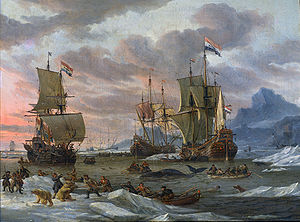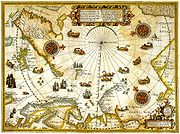
Whaling in the Netherlands
Encyclopedia

Whaling
Whaling is the hunting of whales mainly for meat and oil. Its earliest forms date to at least 3000 BC. Various coastal communities have long histories of sustenance whaling and harvesting beached whales...
in the Netherlands
Netherlands
The Netherlands is a constituent country of the Kingdom of the Netherlands, located mainly in North-West Europe and with several islands in the Caribbean. Mainland Netherlands borders the North Sea to the north and west, Belgium to the south, and Germany to the east, and shares maritime borders...
was a centuries long tradition.The history of Dutch whaling begins with 17th century exploration of Arctic
Arctic Ocean
The Arctic Ocean, located in the Northern Hemisphere and mostly in the Arctic north polar region, is the smallest and shallowest of the world's five major oceanic divisions...
fishing grounds; and the profitability of whaling
Whaling
Whaling is the hunting of whales mainly for meat and oil. Its earliest forms date to at least 3000 BC. Various coastal communities have long histories of sustenance whaling and harvesting beached whales...
in the 18th century drove further growth. Increased competition and political upheavals in Europe affected the stability of this maritime industry in the 19th century; and a combination of these factors cut short any further growth of Dutch whaling in the Antarctic.
Modern, post-war whaling in the southern oceans was developed intensely, but continued growth of Dutch whaling was abbreviated as a result of multi-national treaties which similarly impacted other
national whaling enterprises.
The current Dutch government supports a moratorium on all whaling worldwide.
History

The beginnings of Dutch whaling are indirectly attributed to Willem Barentsz (anglicized as William Barents or Barentz) (1550–1597), who was a Dutch navigator and explorer, a leader of early expeditions to the far north. On his last voyage, Barentsz accompanied Jacob van Heemskerck as pilot, and Gerrit de Veer
Gerrit de Veer
Gerrit de Veer was a Dutch officer on Willem Barentsz' third voyage in search of the Northeast passage. De Veer kept a diary of the voyage and in 1597 was the first person to observe and record the Novaya Zemlya effect, and the first westerner to observe hypervitaminosis A caused by consuming...
, the historian of the voyage, was on board as first mate. This expedition's discovery of the Arctic archipelago of Spitsbergen
Spitsbergen
Spitsbergen is the largest and only permanently populated island of the Svalbard archipelago in Norway. Constituting the western-most bulk of the archipelago, it borders the Arctic Ocean, the Norwegian Sea and the Greenland Sea...
(now known as Svalbard
Svalbard
Svalbard is an archipelago in the Arctic, constituting the northernmost part of Norway. It is located north of mainland Europe, midway between mainland Norway and the North Pole. The group of islands range from 74° to 81° north latitude , and from 10° to 35° east longitude. Spitsbergen is the...
) was to become the foundation for lucrative Dutch claims to the whaling grounds in and around the islands. In the fierce competition for the best whaling grounds, the Dutch construed that that other nations had less right to hunt whales in waters which had been "discovered" by Dutch explorers.
The development of Dutch whaling and sealing saw changes in the composition of crews, in shipbuilding technology, in governmental involvement and in the profitability of the industries.
17th century
The numbers of whaling ships outfitted in the Netherlands grew rapidly—more than doubling in a decade to 70 ships in 1654, and more than doubling again to 148 ships in 1670. The ships involved in whaling helped to make the Dutch Republic one of the richest nations of the 17th century, but this resource was ruthlessly exploited; and by the mid-17th century the catches decreased as the favoured whales became rare.Whaling in the waters around Spitsbergen shifted after 1670 because of a modification of the whales migratory patterns. Some have attributed this change to a global warming trend which permitted the whales to return to their normal summer grounds off the northeast coast of Greenland, but it could have been simply that whales who had survived aggressive whale hunting in earlier seasons were simply avoiding the whalers.
In 1684, 246 Dutch whalers captured 1,185 whales in the waters off Spitsbergen. Typically, whaling expeditions hunted the Bowhead whale
Bowhead Whale
The bowhead whale is a baleen whale of the right whale family Balaenidae in suborder Mysticeti. A stocky dark-colored whale without a dorsal fin, it can grow to in length. This thick-bodied species can weigh to , second only to the blue whale, although the bowhead's maximum length is less than...
, which is a slow-moving unhurried creature which yields plenty of oil. Their high percentage of body fat also meant that they floated when dead and, therefore, were easy to tow back to the land.
18th century

19th century
Amongst the political and economic consequences of the Treaty of AmiensTreaty of Amiens
The Treaty of Amiens temporarily ended hostilities between the French Republic and the United Kingdom during the French Revolutionary Wars. It was signed in the city of Amiens on 25 March 1802 , by Joseph Bonaparte and the Marquess Cornwallis as a "Definitive Treaty of Peace"...
was that control of the Cape of Good Hope was wrested from the British and restored to the Netherlands. This reanimated the prospects for profitable Dutch whaling in the antipodes. In the wake of the British and the Americans, the Dutch made attempts to organize whaling in the Southern Ocean, including the Afrikaanse Visscheriji Societeit (the African Fishery Society) which was founded in Amsterdam in 1802.
A significant system of subsidies issued by the King and his ministers supported Dutch entrepreneurs, which minimized a competitive disadvantage in a period of international whaling with similar financial incentives being funded by many national governments. In this context, a lack of quality in the art of shipbuilding and in the training of seamen has been regarded as very important factors in explaining the ultimate failure of the Dutch whaling industry in the late 19th century.
Dutch culture
.jpg)
Dutch Republic
The Dutch Republic — officially known as the Republic of the Seven United Netherlands , the Republic of the United Netherlands, or the Republic of the Seven United Provinces — was a republic in Europe existing from 1581 to 1795, preceding the Batavian Republic and ultimately...
as a great maritime power and the rise of the seascape as a distinct art form in the Low Countries
Low Countries
The Low Countries are the historical lands around the low-lying delta of the Rhine, Scheldt, and Meuse rivers, including the modern countries of Belgium, the Netherlands, Luxembourg and parts of northern France and western Germany....
The works of this period included vessels sailing, trading, fighting, fishing and whaling; and each individually and collectively display aspects of an evolving Dutch culture The artists' depictions of whaling expeditions help to establish the economic importance of whaling to the Dutch during the late 17th century. and its "Golden Age."
In remarks at the opening of an exhibit of paintings which, in part, focus on Dutch whaling, the Dutch Ambassador to the Court of St. James suggests a relevant broader perspective:
- "The revolt against the most Catholic Spanish overlords and the subsequent menacing of the small rebel Dutch republic by virtually all great powers of Europe made them realise that their struggle for survival could only by won by the fierce protection of the freedom of the Netherlands’ single natural resource .... We learned to harness the sea; however, like a horse, the sea can never be conquered. Our national identity can be easily traced back to the whims of the water.... It is the Dutch and Flemish masters of the 16th and 17th centuries who have indeed come close to conquering the sea by fixing its capriciousness on panel and canvas."
The economic success of the Dutch Republic was inextricably linked with the sea as were the emerging national identity and international reputation of the young state. Many in the Netherlands earned their fortune in Arctic whaling; however the success of whaling scenes in Netherlandish painting cannot be entirely explained by economic interest.
Modern whaling
In 1964, the last Dutch factory ship, poetically named Willem Barrentsz, was sold to Japanese whaling interests, thus bringing a conclusive end to the long history of Dutch whaling.During the period 1946-1964, the involvement of the Netherlands in modern, post-war whaling in the Antarctic was aggressively pursued.
The current Dutch government opposes the practice of whaling; and the Netherlands is committed to seeing new and improved binding agreements made within the International Whaling Commission.
External links
- The North Atlantic Marine Mammal Commission
- International Whaling Commission
- Netherlands Maritime Museum: Nederlands Scheepvaartmuseum, Amsterdam

